Video clip on using bilingual books, example of My Face Book from Star Bright Books
Video clip here
Shapes That Roll by Karen Nagel--Video Clip
Video clip demonstration of Empower Aside using Shapes That Roll and other manipulatives.
Click here
Saroj Ghoting, Early Childhood Literacy Consultant
Cars Galore by Peter Stein
Video clip demonstration of an example early literacy aside emphasizing vocabulary using the book Cars, Galore by Peter Stein.
Click here
Saroj Ghoting, Early Childhood Literacy Consultant
Using facutal books--Video Clip
Video clip explaining why we use factual books in storytimes and demonstrating Empower Aside using the book Termites on a Stick by Michelle Coxon
.Click here
Saroj Ghoting, Early Childhood Literacy Consultant
Handout with Empower Aside--Three Little Pigs--Video Clip
Video clip of demonstration of Empower Aside using a handout, encouraging narrative skills, using Three Little Pigs.
Click here
Saroj Ghoting, Early Childhood Literacy Consultant
Planning Your Early Literacy Asides--Video Clip
Video clip on planning the three early literacy asides in your early literacy enhanced storytime: explain aside, example aside, empower aside. Uses the book Farm Animals by Simms Taback as the example.
Click here
Saroj Ghoting, Early Childhood Literacy Consultant
ABC Look at Me by Roberta Intrater
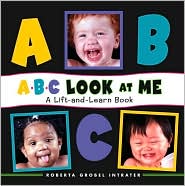
Early Literacy Aside: Explain Aside: Noticing that the same letter can look different, like upper and lower case, is a beginning step for letter knowledge, one of the early literacy skills that children need to be able to learn to read.
Early Literacy Aside--Example Aside: One way we can help children learn what the letters look like and the letter names is by sharing alphabet books. When sharing alphabet books with children, we tend to focus more on the print than with any other type of book. Let’s share an alphabet book together.
Share the book ABC Look at Me by Roberta Intrater. Did you notice that when I read the book, I pointed to the letter? As we read alphabet books, we tend to point out the letter on the page as we say its name. This does not come so naturally while reading other kinds of books. As you talk about the letter you can point out that the same letter can look different. For example, here’s the letter R. It can look like R or r.
Empower Aside: When you read alphabet books, don’t worry if your child does not recognize the letters and the different ways they look. You are just introducing the idea that the same letter can look different. Alphabet books do not need to be read from A to Z. You can give the book to your child and let them choose a page that looks interesting. Then talk about the picture and the letter. As your child grows, keep pointing out and talking about letters. Let your child see your interest in them and they will follow your lead in learning them.
Goodnight Max by Rosemary Wells
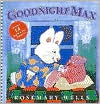
Introduction: Let's look at the cover of this book Goodnight Max by Rosemary Wells. What shapes do you see? Yes, the blanket has colored squares, the moon is a crescent shape; Max's nose looks like a triangle.
Read the book.
Early Literacy Aside--Example Aside: You don't need a book about shapes to talk about shapes. Talking about shapes with your child as we did at the beginning of this book, is the beginning of being able to recognize letters. Children begin to recognize letters by their shapes.
Hush, A Thai Lullaby by Mingfong Ho
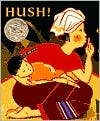
Early Literacy Aside--Explain: Today our early literacy tip is on hearing the smaller sounds in words. This pre-reading skill will help children later sound out words when they learn to read. [The skill is called phonological awareness.] I'll be pointing out some activities you can do to support this skill as you read with your children.
Introduction:Hush: A Thai Lullaby by Mingfong Ho is our next book. It is about a mother in Thailand singing a lullaby to her baby.
Early Literacy Aside--Example: This book has both animal sounds and rhyming words. Both of these activities, hearing and saying animal sounds and hearing and saying rhyming sounds and words support one of the early literacy skills, phonological awareness.
Read the book. Have participants join in with saying the sounds of the animals. After you read the book, come back to a page and talk about two words that rhyme. Have the children think of other words that rhyme--remember they can be nonsense words.
Early Literacy Aside--Empower: Today I pointed out some activities around the early literacy skill phonological awareness: hearing different sounds such as animal sounds, as we just did and having children make those sounds. For older children, we want them to be able to hear the smaller sounds in words, the syllables, to be able to hear and make the beginning sound in a word, to be able to hear and make rhyming words, and to play with these sounds. Researchers know these are important skills for later when your child tries to sound out words. Children develop at different stages and some things will be harder for some and easier for others. It is easier to recognize a rhyme than to make a rhyme, so if your child cannot rhyme a word, say two words and ask if they rhyme. By doing these activities, you will be helping your child enter school ready to learn to read.
Look at Me (Begin Smart Books)
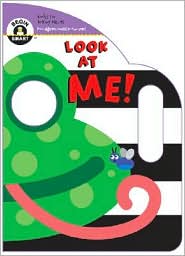
Early Literacy Aside--Explain: Making book sharing times enjoyable times helps to develop your child's print motivation, enjoyment of books and reading. Research shows that children who have had enjoyable experiences around books are more likely to stick with learning to read, when that time comes.
Early Literacy Aside--Example: One thing that helps to keep book time enjoyable is to have your child participate in reading the book. This can be done in several ways. For example, having your child turn the pages, letting your child choose the book to be read or a picture to talk about, or having your child chime in with animal sounds or a word or two. Our book today is called Look at Me. This book lends itself to playful interaction because it has a repeated phrase, "Look at me," AND it's a book-a-boo book, making it a game. Everyone, all together, let me hear you say look at me! Good, try it again. Look at me. Good! Now you'll say that as I read the book with you. Share book using peek-a-boo game, having children say the animals and make the animal's sound. [The lion is the first animal. If that is scary for some children, start with a different animal. Some children may be afraid if you cover your own face. Suggestion--Use a doll or stuffed animal and cover it's face to play peek-a-boo.]
My First ABC Board Book (DK)
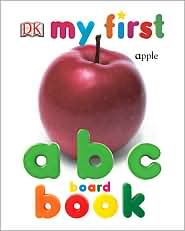
Early Literacy Aside--Example: Sharing alphabet books is one way to introduce children to letters. This book My First ABC Board Book has bright, clear photographs of things that interest young children.
Share a page or two: For example, on the B page, we see a baby, bananas, a ball, and bread. We see both the upper and lower case letter so children see that the same letter can look different. You can give the book to your child and let him choose a page to talk about. Talk about the pictures and point out the letter.
Early Literacy Aside--Empower: Naming the letters and pointing to them is a first step to developing your child's letter knowledge, one of the six early literacy skills. You can do this with books and also with signs whenever you are out and about. Remember to keep it enjoyable and stop when your child has had enough. No need to quiz your child on the letters, just expose them to the letters.
Color Zoo by Lois Ehlert
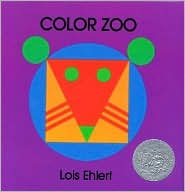
Early Literacy Aside--Explain: The beginning of letter knowledge, one of the six early literacy skills, is seeing and recognizing shapes. Researchers have found that children learn to recognize letters by their shapes. I'll be pointing out some ways that you can use books to talk about shapes.
Early Literacy Aside--Example: Our next book is Color Zoo by Lois Ehlert. It is really fascinating how you can see the animals just using basic shapes. What animals do you see? Sharing books with stark shapes like this is a first step to recognizing letters later. Read the book. Talk about the shapes as well as the animals. The back of the book are the separate shapes which you can also point out or refer to from time to time as you read the book.
Early Literacy Aside--Empower: This is quite a sophisticated book and can be used in many ways with very young children and also as your children get older. Start with simply noticing shapes and bright colors and your older children can make animals from shapes themselves.
Dear Zoo by Rod Campbell
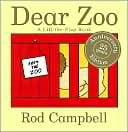
Introduction: I'd like to share this book with you called Dear Zoo by Rod Campbell. It can be tricky to use with little hands. Sometimes children tear the flaps because they don't have good coordination yet. They do like flap books because they can play with the book and it's a kind of peek-a-boo game.
Early Literacy Aside--Example: This simple story has signs which supports the early literacy skill called print awareness, helping your child understand that print has meaning. Pointing to the words on the signs as you read the book helps children understand that these are the words we are saying.
Read book. Point to the words in the signs as you read.
Early Literacy Aside--Empower: As you go around your day, point out signs to your children. Even when your children notice logos like on gas stations, stores, or restaurants, this is the beginning of print awareness.
Please, Baby, Please by Spike and Tonya Lee

Introduction: Our book today is called Please, Baby, Please written and illustrated by Spike and Tonya Lee. Some of the things this baby does may look quite familiar to you! When you read this book to your baby, you can read the words or talk about the pictures.
Read book Please, Baby, Please by Spike and Tonya Lee. When you read the book with your child, don’t worry about getting through the whole book! Leave a little time when you are talking about the pictures, to let your child babble back to you. Now let’s all say this phrase, “please baby please” together. I’ll read part of this book again and let’s all chime in with “please baby please." You’ll notice I made this phrase repeat throughout so your toddler can join in. It is easier with the repetition. You may also like to try sign language. For children who are pre-verbal, can’t say words yet, using gestures is one way they make themselves understood. Just be sure to SAY the words as you use the gestures and encourage your child to do so as well. [See attachment for signs.]
Early Literacy Aside--Example: By encouraging your child to speak, to repeat words, you are helping to develop their narrative skills. This is the expressive part of language which later helps to develop comprehension when they read. Even giving time for your baby to babble as you share books together is helping with to develop this skill.
Sign language please baby please
Fire Truck by Peter Sis
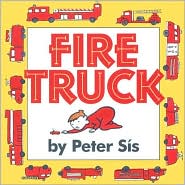
Introduction: This book Fire Truck, written and illustrated by Peter Sis, has lots of interesting words in it.
Early Literacy Aside--Example: Listen to the many different words your child is hearing, words we might be using in everyday conversation. Because books have three times as many rare words as we use in conversation, it is important for children to hear the language of books. As I'm reading this book, just hold up a finger when you hear a word you would not be using everyday when talking with your child. Then we'll see how many you heard at the end of the book.
Read the book. Ask how many words they heard that they would not use in conversation with their children.
Early Literacy Aside--Empower: As you read books at home with your children, you may notice some words they are not familiar with. You don't have to explain every unfamiliar word, but you might choose one to point out and explain. Don't replace unfamiliar words, or they won't hear them. This is how you help their vocabularies grow!
I'm Taking a Trip on My Train by Shirley Neitzel

Introduce book: This book about a train uses pictures for for some words. You can help me by filling in the words when you see the picture.Read book: As you read the book, point to the pictures in the text so that the participants (children and adults) will chime in with the appropriate words.
Early Literacy Aside--Example: (Print Awareness) As you point to the pictures and have children say the words, you are helping them see that pictures represent words. This is the beginning to helping them understand that the written word also represents the words we say. Print awareness is one of the skills children need to be able to learn to read and you are helping to develop this skill when you point to pictures and words as you say words.
Early Literacy Aside--Empower: (for Print Awareness) Having words as part of the text of the story is a fun way to write stories with your child. As your child tells you a story, you can write it down and let them draw pictures for some of the repeated words. They see the written words for their spoken words which develops print awareness.
Early Literacy Aside--Example: (for Narrative Skills) Having your young children chime in with a word or phrase, as much as they can remember, is a first step to being able to retell the whole story. Retelling stories helps children develop narrative skills which later helps them understand what they read.
Early Literacy Aside--Empower: (Narrative Skills) This is a cumulative story, where the lines are repeated. Having your child say the repeated phrases helps to develop retelling the story which develops their narrative skills, one of the skills that helps with later reading. Retelling stories helps develop their understanding of the story as well.
Choose only one skill to highlight (to say the aside).
Pouch by David Stein
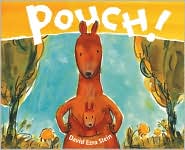
Introduce the book: Our next book is Pouch by David Stein. Mother kangaroos carry their babies in a pouch, like a little pocket in front of their stomachs. This baby kangaroo called a Joey is exploring the world and sometimes wants to feel safe in his pouch. Then he yells, "pouch". Can you say that with me? Pouch! Good, try again. Pouch! Each time we come to the word pouch, you say it with me.
Read the book, pointing to the word pouch as you say it.
Early Literacy Aside--Example (for Print Awareness): The word pouch is written in bold letters which makes it easy to point out as your child says the word. Pointing to the word helps them understand that you are reading the text, the written word. This helps develop print awareness, knowing that print has meaning, one of the early literacy skills.
Early Literacy Aside--Example (for Print Motivation): By having your child participate in the story by saying "pouch" each time, you are helping to keep your child engaged in the story in an enjoyable way. This helps to develop print motivation, your child's interest and enjoyment of books and reading. Print motivation is one of the six early literacy skills, the one that later keeps children trying to learn to read even when it can be difficult.
Choose only one skill to highlight (to say the aside).
Big Chickens Go To Town by Leslie Helakoski

Introduction to book: Our next book is Big Chickens Go to Town by Leslie Helakoski. There are a couple of other Big Chicken books and I think they are very funny. See what you think.
Read the book taking your cue for voice expression from the pictures.
Early Literacy Aside--Example (for Vocabulary): This book has so many interesting words. Use them all, like "the chickens bawled, squalled and caterwauled." This is how your child's vocabulary will grow. Even if they (or you) don't understand every word, you can get the idea from the story itself. That's one of the wonderful things about books, they have so many interesting words.
Early Literacy Aside--Example (for Phonological Awareness): This book has many rhyming words. [Demonstrate with one page. For example, reread the page that starts Shouting voices wobbled.] Wobbled rhymes with bobbled. Flumped rhymes with bumped and rushed rhymes with crushed. Let's think of some other words that rhyme with crushed. They don't even have to make sense. (mushed, brushed, zushed) Pointing out and making rhyming words helps to develop one of the early literacy skills called phonological awareness--hearing the smaller sounds in words. This will later help your child sound out words when they learn to read.
Choose only one skill to highlight (to say the aside).
Eats by Marthe Jocelyn
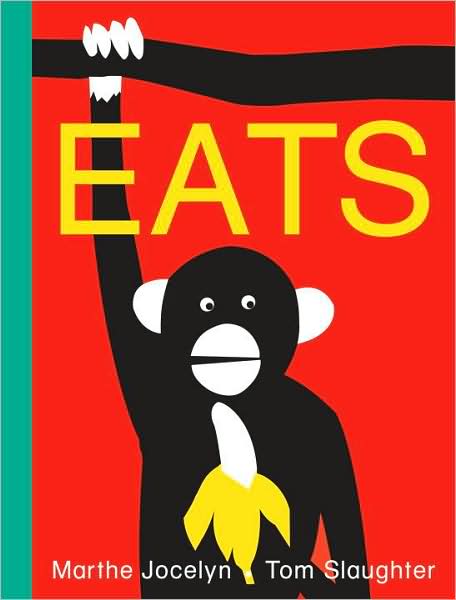
Introduce book: Our next book is Eats by Marthe Jocelyn and Tom Slaughter. You will see that they use very stark and bright colors, making it easy for young children to see the pictures. There are just two words on a page, the animal and what it eats. Children let's see what the animal is right on the cover. A monkey! and he is eating a banana. Yummy!
Read the book. Point to some of the words as you read them.
Early Literacy Aside--Example (for Print Awareness): You may have noticed when I read the book that I not only pointed to the pictures but also to the words. The words are so distinct. It is as if they are part of the artwork. Pointing to the words as well as the pictures helps your child focus on the print. They can see that pictures and words represent real things, part of print awareness, one of the early literacy skills that will later help them to read.
For Vocabulary: Read the book. Add some more information as you talk about the pictures. Fore example: Bees like to eat nectar. See the black and yellow striped bees? They make a buzzing sound. Let me hear you make a buzzing sound. Good! Nectar is a sweet liquid that flowers have and the bees love to eat it.
Early Literacy Aside--Example (for Vocabulary): Even though there are just one or two words on a page, you may have noticed that I said more than just those words when I read the book. When you read books with your children take time, especially with simple books like this, to add more information to the words on the page. This helps build their vocabulary, learn new words.
Choose only one skill to hightlight (to say the aside).
A Truck Goes Rattley-Bumpa by Jonathan London
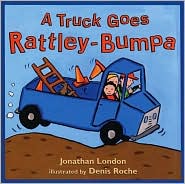
Read book.Say: Some of the pictures in this book have words on the trucks or on signs. Let's see what they say. Choose a page or two with some signs such as MILK or ICE CREAM or MOVERS and point to the words as you say them.
Early Literacy Aside--Empower: In the book A Truck Goes Rattley-Bumpa, I pointed out the words in the pictures you help develop print awareness. When you are out and about, be sure to point out words as you talk about the signs you see all around you.
